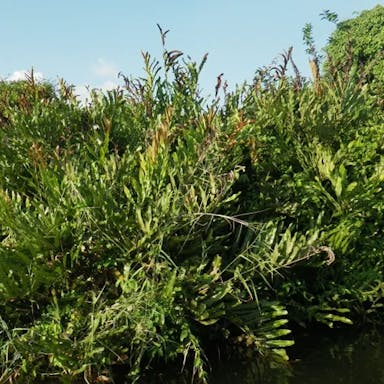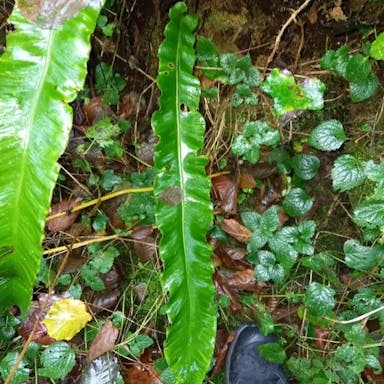Ebony spleenwort has two common varieties: A. australasicum and A. bulbiferum. When selecting seedlings, look for healthy, vibrant green fronds without signs of discoloration or damage. For seeds, choose those that are plump, firm, and free of mold or pests. Ensure seedlings have well-developed roots and are not root-bound. A. australasicum prefers moist, shaded areas, while A. bulbiferum thrives in well-drained soil with partial shade. Consider the growing conditions in your garden before making a selection.
Ebony spleenwort
- Scientific name
- Asplenium platyneuron
Basic Information
- Aspleniaceae Family Asplenium Genus Ebony spleenwort Species
- Aspleniaceae > Asplenium > Asplenium platyneuron
- 83%
- The Completeness of This Encyclopedia
Please help us complete the encyclopedia, Terrarium is a encyclopedia service to be completed with everyone in the world. Currently, this page is 83% complete. For more information on how to contribute, please click here.
- Pteridophyta
- Height
- 30cm ~ 90cm
- Flower Color
- Leaf Color
- Anthesis
- Sunlight Exposure
Full Sun Long hours of sunlight from morning to afternoon Partial Shade A location in the shade of a tree or where either the morning or afternoon is shaded Full Shade A place where there is no direct sunlight
- Partial Shade
- Hardiness Zones
This is an indicator to know to which zone each plant can winter. Knowing the zone of each plant gives you an idea of the cold temperature resistance when grown in the ground without a roof. 2: -42.7 to -40.0 3: -39.9 to -34.4 4: -34.3 to -28.9 5: -28.8 to -23.3 6: -23.2 to -17.8 7: -17.7 to -12.2 8: -12.1 to -6.7 9: -6.6 to -1.1 10: -1.0 to 4.4 11: 4.5 to 10.0
- 3-8
- Cold resistance
- Excellent
- Heat resistance
- Fair
- Habitat of origin
- North America
- Growth Rate
- Normal
What is Ebony spleenwort (Asplenium platyneuron)?
What is Ebony spleenwort (Asplenium platyneuron)
Flower meaning
Ebony spleenwort, scientifically known as Asplenium platyneuron, is a perennial fern native to North America. It is characterized by its dark green, lance-shaped fronds that can reach up to 18 inches in length. The plant typically grows in rocky woods, crevices, and cliffs, preferring shaded and moist environments. Ebony spleenwort does not produce flowers; instead, it reproduces through spores located on the undersides of its fronds. The spores are typically brown or black in color. This fern is classified as an evergreen, meaning it retains its foliage throughout the year. Asplenium platyneuron is known for its ability to adapt to various growing conditions, making it relatively easy to cultivate in home gardens or natural landscapes. The plant does not produce fruits but instead releases spores for reproduction. It is a popular choice for shaded gardens or as a ground cover due to its elegant appearance and low maintenance requirements.
Calendar of Ebony spleenwort (Asplenium platyneuron)
Calendar
Ebony spleenwort is susceptible to pests such as aphids, spider mites, and scale insects, which can cause damage by feeding on the plant's tissues. These pests can weaken the plant, leading to stunted growth and yellowing of the leaves. To prevent infestations, regular inspection of the plant for early signs of pest presence is crucial. Additionally, maintaining proper plant hygiene by removing any affected leaves or branches can help prevent the spread of pests. Ebony spleenwort is also prone to diseases like leaf spot and root rot. Leaf spot is characterized by dark spots on the leaves, while root rot causes the roots to decay, leading to wilting and eventual death of the plant. Proper watering practices, such as avoiding overwatering, and ensuring good air circulation around the plant can help prevent these diseases. Regularly monitoring the plant's health and addressing any issues promptly can aid in maintaining the Ebony spleenwort's vitality.
How to grow Ebony spleenwort (Asplenium platyneuron)
Watering
The flower language commonly used in America for the Ebony spleenwort plant is resilience and perseverance. Examples of flower language: - Resilience: symbolizes the ability to bounce back from challenges. - Perseverance: signifies determination and persistence in the face of adversity. Explanation: The Ebony spleenwort's flower language of resilience and perseverance reflects its ability to thrive in various conditions, symbolizing strength and endurance in the language of flowers.
Soil and Fertilizer
Ebony spleenwort thrives in partial to full shade, making it suitable for areas with limited direct sunlight. It exhibits moderate cold tolerance, able to withstand cooler temperatures but may struggle in extreme cold conditions. It prefers temperatures ranging from 60-75°F (15-24°C) and should be protected from intense heat to prevent leaf scorching. During summer, it benefits from dappled sunlight or morning sun to avoid heat stress. In winter, it can be overwintered indoors or in a sheltered location to protect it from frost. Optimal placement includes under trees or in shaded garden beds. It is best to provide it with indirect sunlight for 4-6 hours per day to maintain its health and vigor.
Sunlight and Place
When watering Ebony spleenwort, ensure the soil remains consistently moist but not waterlogged. During the growing season, water the plant every 7-10 days, allowing the top inch of soil to dry out between waterings. In winter, reduce watering frequency to every 2-3 weeks as the plant's growth slows down. Check the soil humidity by inserting your finger into the soil; if it feels dry, it's time to water. Avoid overwatering, as this can lead to root rot and other issues.
Advanced Information of Ebony spleenwort (Asplenium platyneuron)
Pruning
Ebony spleenwort thrives in well-drained, acidic soils with a pH range of 5.5 to 6.5. It prefers rich, organic soil with good moisture retention. Fertilize in early spring with a balanced slow-release fertilizer to promote growth and in late spring with a high-phosphorus fertilizer to encourage root development. Apply fertilizer sparingly to avoid nutrient imbalances, following the manufacturer's instructions for the specific product. Avoid over-fertilization, as it can harm the plant. Monitor soil quality regularly to ensure it remains suitable for Ebony spleenwort. Consider conducting soil tests periodically to adjust fertilizer applications accordingly.
Planting and Harvest
Ebony spleenwort benefits from regular pruning to maintain its health and appearance. Pruning helps remove dead or damaged fronds, promoting new growth and preventing overcrowding. It is best to prune Ebony spleenwort in late winter or early spring before new growth emerges. To prune, use clean, sharp scissors or pruning shears to cut back any yellowing or brown fronds at the base. Avoid cutting into the healthy green fronds. After pruning, water the plant thoroughly to encourage new growth. Regularly inspect the plant for any signs of pests or diseases post-pruning.
Propagation
Ebony spleenwort is best potted for controlled growth. Use a well-draining potting mix to prevent waterlogging. Place the plant in a location with indirect sunlight. Water the plant when the top inch of soil feels dry. Fertilize monthly during the growing season. Repot every 2-3 years to refresh the soil and provide more space for growth. When repotting, gently loosen the roots and place in a slightly larger pot. Mist the plant regularly to maintain humidity. Watch for signs of pests like spider mites or aphids. If infested, treat with insecticidal soap. Prune any damaged or yellowing fronds to encourage new growth.
Pests and Diseases
Ebony spleenwort can be propagated through spores or division. Spores are collected from mature fronds and sown on a suitable growing medium. Division involves separating the plant into smaller sections, each with roots attached. To propagate through spores, harvest mature fronds, place them in a paper bag to dry, and collect the spores. Sow the spores on a moist growing medium and cover with a plastic bag to maintain humidity. For division, carefully separate the plant into sections, ensuring each has roots. Plant the divisions in a suitable potting mix and keep moist until new growth appears. By utilizing both spore propagation and division methods, you can increase the chances of successful propagation and establish new plants more efficiently.
Habitat of Ebony spleenwort (Asplenium platyneuron)
Habitat
Toxicity of Ebony spleenwort (Asplenium platyneuron)
Health Benefits
- edible
- Inedible
- Toxic
- No toxicity
NO DATA
Toxic for dogs and cats
NO DATA
Q&A of Ebony spleenwort (Asplenium platyneuron)
- Is there a recommended way to choose Ebony spleenwort?
Ebony spleenwort typically blooms in the spring and early summer in the United States. The flowers of this plant are at their best during the month of May. Blooming occurs once a year, usually lasting for a few weeks. To encourage longer blooming periods, ensure the plant receives adequate sunlight, water, and nutrients. Maintaining consistent moisture levels in the soil can also help prolong the flowering period. Pruning any dead or faded flowers can stimulate new growth and extend the blooming season. It is essential to monitor the plant's health and address any issues promptly to support continuous blooming.
0
0











